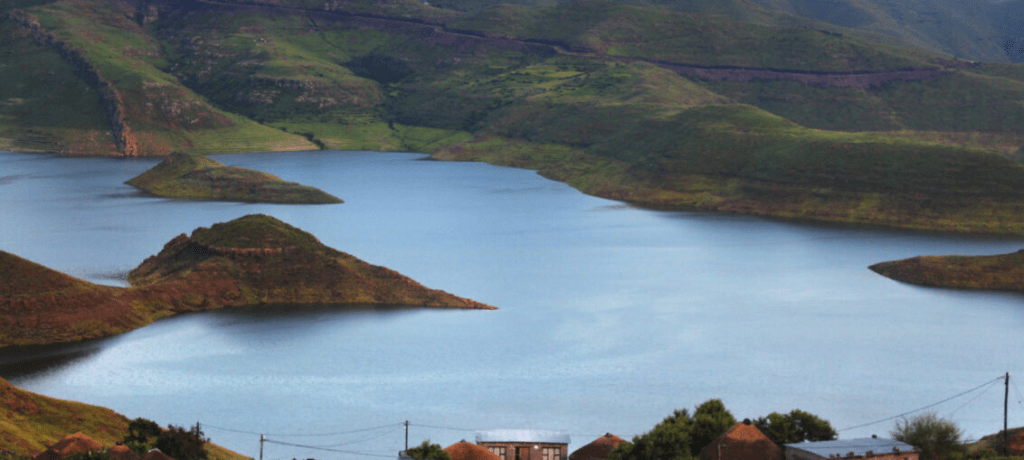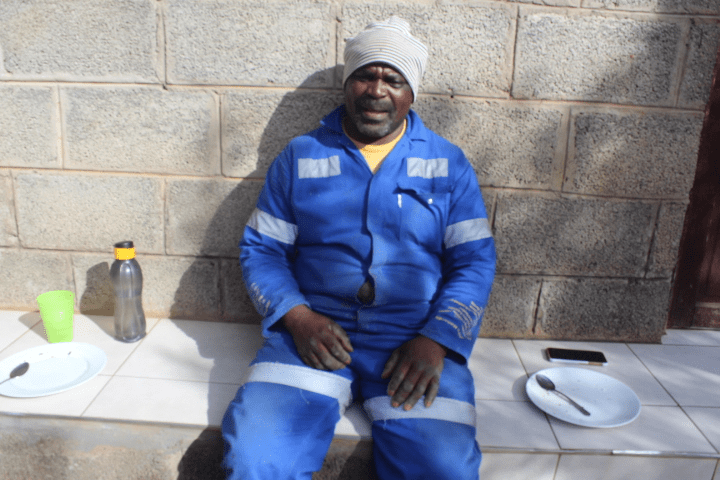How South Africa’s Water Needs Plunged Lesotho Into Food Insecurity
1 August 2022 by Pascalinah Kabi
Bertha Foundation Fellow

Landlocked Lesotho, is currently experiencing severe food insecurity as a result of a deal to meet neighbouring South Africa’s ever-increasing water needs.
The Lesotho Highlands Water Project (LHWP) was billed as one that would bolster Lesotho’s position in the regional political economy and reassert its sovereignty. But, the reality has been very different, especially for poverty-stricken citizens who rely on locally grown crops to feed their families.
In the first phase of the LHWP the two dams that were constructed, the Katse and Mohale, were designed to meet the ever-increasing water needs of South Africa’s most populated province, Gauteng.
Lesotho offered up to 1,900 hectares of its most productive arable land and 5 000 hectares of grazing land for the construction of these dams. While the Katse and Mohale dams were finished in 2003, the second phase of the multi-million Maloti water project is now underway with the construction of the Polihali Dam.
Aside from the arable land being flooded to make way for these dams, serious concerns have also been raised about the cleanliness of the Khubelu River, one of two critical rivers in phase two of the project. This river has been polluted with nitrates by the Letseng Diamond Mine, as MNN revealed in May of this year.
The water project’s proponents, according to Professor Oscar Gakuo Mwangi of the National University of Lesotho (NUL), disregarded environmental threats to Lesotho, especially the loss of the country’s most productive arable land.
The consequences of doing this were, argues Mwangi, either ignored or downplayed in the name of development. Mwangi stresses how the Mohale valley land that was flooded for the dams was “ the only one in the country to produce an agricultural surplus”.
“These rich alluvial soils, which had been enhanced by natural deposits of minerals from the rivers, produced the highest yields of agricultural products in the country,” said Mwangi in his report, Hydropolitics versus Human Security: Implications of South Africa’s Appropriation of Lesotho’s Highlands Water, which was published in October 2021.
The deal for Lesotho under the Under LHWP was that it would benefit from the hydroelectricity the project generated and South Africa would also pay water royalties to help finance Lesotho’s national development plans.
While the benefits of this project were billed as significant, the reality has not been as rosy, especially for two-thirds of Lesotho’s population in the affected areas who depend on locally grown crops.
Experts agree that the loss of arable land has had a negative impact on local food security. The question is whether the benefits Lesotho was supposed to get from the LHWP outweigh the loss of this arable land.
By the end of 2021, Lesotho had earned M12,8 billion for selling 17,503.4 million cubic meters of water to South Africa, according to the Lesotho Highlands Development Authority (LHDA).
Mwangi says Lesotho has transformed from one of the largest sources of labour to a water reservoir for South Africa.
South African Ministry of Water spokesperson, Sputnik Ratau, had not responded to questions at the time of going to print despite acknowledging receipt of MNN queries.
But at what cost to human suffering?
Mwangi argues that the food security threats have devastating effects on resettled communities and the country’s ecosystem, adding that this “constitutes both a domestic and an international security threat”.
“Though the project (LHWP) provides mutual strategic economic and political benefits to both riparian states, its construction has negatively affected environmental and human security in Lesotho,” Mwangi said.
Colin Hoag, an assistant professor of environmental anthropology from the United States, agrees with Mwangi’s view and, in an exclusive interview with MNN, said: “The problem is that the project is portrayed as a means of improving livelihoods when it is difficult to make such a case…and as a benefit for the country, when in fact there are many, many people in Lesotho who do not benefit.”
While the highlands water project is widely regarded as an African success story supposedly mutually beneficial socio-economic development between Lesotho and South Africa, Hoag, argues: “South Africa is the primary beneficiary”.
“(South Africans) need cheap water to make life and industry possible in Gauteng, and they have it. Given how important this water is to Gauteng, it is astonishing to me that the terms aren’t more favourable to Lesotho. That said, South Africa has preyed upon Lesotho for a very long time—first for migrant labour and now for water—so this shouldn’t surprise me,” said Hoag, who believes the terms of the deal should be reviewed.
Hoag argues Lesotho’s “water is a gift that destroys”. In his 2019 academic research, he argues that optimism among the Lesotho elites that water export would bolster Lesotho’s position in the regional political economy and reassert its sovereignty existed before and after the signing of the water treaty between Lesotho and South Africa.
Although Hoag is quick to acknowledge that the project’s hydroelectricity component has marginally reduced electricity costs, he contends that many areas of the country, including many residents of the LHWP project areas, still lack access to electricity.
“While the jobs created by the project’s construction were welcome, they were temporary. The LHWP employs very few people in the aftermath of construction. So, apart from the roads and royalties, it seems to me that the beneficiaries of the LHWP were construction companies and Gauteng.
“Not only are there many people who do not benefit from the LHWP, but there are many who actually suffered as a result of relocation, increased HIV/AIDS rates and alcoholism around LHWP project sites, loss of grazing or agricultural land, and inadequate compensation,” Hoag argues. Attempts to obtain comment from the South African government were unsuccessful as Ministry of Water spokesperson, Sputnik Ratau had not responded to written questions despite confirming receipt of such inquiry.
‘Water is a gift that destroys’
Lesotho, according to a global platform that provides news on water projects, Water Technology, has plentiful water resources that (arguably) go beyond what is needed for development and irrigation projects that could possibly be undertaken in the future.
“The total water consumption in Lesotho is about 2m³/s, while the total availability is about 150m³/s,” says Water Technology.
Lesotho’s only neighbour, “South Africa has had a long history of water shortages, which have only been exacerbated by the post–World War I urban and industrial booms”, according to Mwangi.
To meet the expanding needs of South Africa’s more than 50 million people, the country’s annual yield of 49,200 million cubic meters is insufficient. The lack of potable water has been made worse by declining rainfall brought on by climate change and rising water pollution.
Lesotho is one of the few countries in the world that exports water. This was after Sir Evelyn Baring, the British High Commissioner to Lesotho, recognized the LHWP as the most cost-effective method of supplying water to South Africa in the 1950s.
The 57-year-old Mohlalefi Sekolopata is an example of the toll that this project has taken on ordinary people’s lives. Sekolopata and his late father leased agricultural plots at Molikalikong, Ha Tsapane, a village now submerged by the Mohale Dam.
“Following in my father’s footsteps, I also opened a shop at Molikalikong, Ha Tsapane and we were successful farmers as well. Although we did not own any farmland at Molikalikong, the locals subleased it to us, and the result was a massive amount of production”, Sekolopata told MNN in June this year.

57-year-old Mohlalefi Sekolopata of Molikaliko, Ha Ntsapa farmer. Credit: Pascalinah Kabi
He adds: “Our produce way surpassed our demand and that of fellow villagers who bought our produce. The water project came into the picture and our food security was taken away with it.”
In one farming season, Sekolopata says he ploughed five or six large farms. He adds that they never measured the farms and instead “used our indigenous knowledge to determine that the farms were large.”
“I basically ploughed everything, including maize, beans, dagga, and peas, including potatoes and cabbage. The most popular item among our customers was an 80-kilogram bag of maize mealie, which was sold for about M80 each and attracted people from nearby villages like Bokong and Ha Sekolopata.
“We would transport potatoes from there and sell them in Maseru. Since I stopped farming, renting out accommodation now provides the majority of my income. The project has threatened my livelihood because I am no longer a semi-commercial farmer. That land was very productive and production was very high. Many people envied us. Both the soil and water output were rich. We simply had a rich wetland where there was plenty of water,” Sekolopata said.
South Africa scores big as Lesotho faces acute hunger
First, Lesotho is a mountainous country of 30 355km squared with approximately nine percent of the national surface area as arable land while 1.1% is water, according to the Bureau of Statistics Lesotho.
Lesotho’s arable land only makes up almost four percent of South Africa’s 12,000,000 arable land in 2018, according to the World Bank. This after Lesotho lost 1, 900 of its most productive land for the water project addressing the ever-growing water needs of South Africa’s economic powerhouse, Gauteng.
Lesotho earns money every year from selling water to South Africa and generating 72 megawatts of electricity for domestic use in exchange for losing its most productive land, which produced surpluses.
Commenting on strong Basotho views that the treaty must be reviewed to ensure that it is more favourable to Lesotho, Hoag said: “I really hope that the treaty can be reviewed and that more favourable terms can be given to Lesotho.”
He argues that the following must be addressed:
· Improved royalty rates that reflect the market demand on South Africa’s side;
· A commitment to ensuring that additional hydroelectricity is part of the Phase II agreement, as this is the project component that most benefits Lesotho;
· South African government contributions to wetland conservation, both by funding such efforts, as well as through contributions of expertise by South African scientists and engineers;
· By opening South Africa’s labour market to Lesotho citizens and facilitating economic development in the highlands.
Hoag is of the opinion that South Africa “wants Lesotho’s water without having to worry about the nation of Lesotho. This won’t work, and it’s not in South Africa’s interest to imagine that it will”.
As a result of rising water demands in South Africa, springs in several villages in the Katse Dam’s catchment area have dried up, reducing the amount of freshwater available to communities. As a result, 700,000 Lesotho citizens currently live in food insecurity.
Furthermore, the United Nations estimates that almost 9,000 children under the age of 5 are severely malnourished in Lesotho.
A 2009 World Food Program (WFP) study estimated that 39 percent of children under the age of five showed signs of stunted growth brought on by malnutrition.
This story was produced and first published by MNN Centre for Investigative Journalism.

